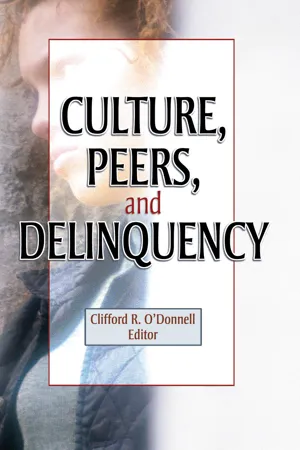
- 112 pages
- English
- ePUB (mobile friendly)
- Available on iOS & Android
Culture, Peers, and Delinquency
About This Book
Increase your understanding of the etiology, prevention, and treatment of delinquency! This informative book provides you with specific strategies to assess delinquency and to increase the effectiveness of any prevention program. In addition, it presents a community peer model of delinquency with important implications for delinquency prevention programs and for delinquency research. Examining specific cultural groups in the United States, including Caucasians, East Asians, South-East Asians, Polynesians/Micronesians, and Vietnamese, as well as Japanese youths in their homeland, this model shows how families, schools, and neighborhoods affect the formation of peer groups—and how these groups can facilitate or inhibit delinquency. Culture, Peers, and Delinquency explores the interplay of historical, traditional culture with contemporary youth culture. It also examines the relationship between individual outcome and community disorganization and illustrates how peer relationships are conditioned by gender. The book will increase your understanding of the etiology, prevention, and treatment of delinquency with examples that show treatment alternatives and outcomes, focusing on:
- intercultural differences in major descriptors of the attitudes and activities of youth
- the demographics, economics, and history, as well as a fascinating and disturbing cultural analysis of the ever-increasing rate of juvenile delinquency in Japan
- the influence of peers and culture on Vietnamese youth gangs in Honolulu
- gender-difference studies of mixed-culture incarcerated adolescents—and what these youths have to say about the detention facility where they go to school
- a careful analysis of homes, schools, and neighborhoods in terms of their dysfunctions and how they increase the likelihood that their youth will spend time with similar peers and without adult supervision
Frequently asked questions
Table of contents
- Cover
- Half Title
- Title Page
- Copyright Page
- ABOUT THE EDITOR
- Table of Contents
- Introduction: Juvenile Delinquency: Culture and Community, Person and Society, Theory and Research
- The Effects of Cultural Differences on Peer Group Relationships
- Juvenile Delinquency in Japan
- Vietnamese Youth Gangs in Honolulu
- Juvenile Delinquency: Peer Influences, Gender Differences and Prevention
- Culture, Peers, and Delinquency: Implications for the Community-Peer Model of Delinquency
- Index